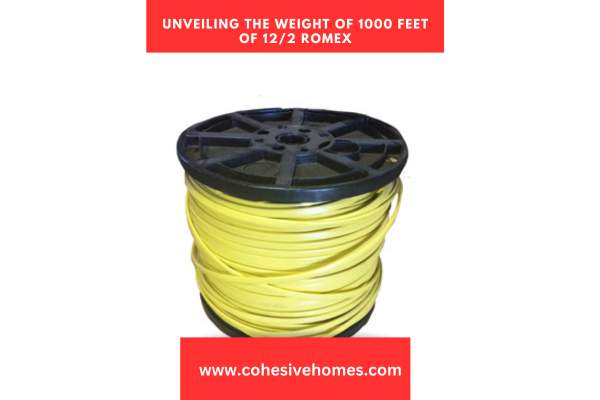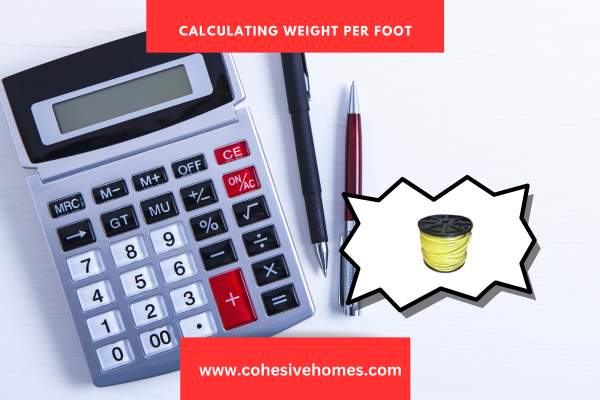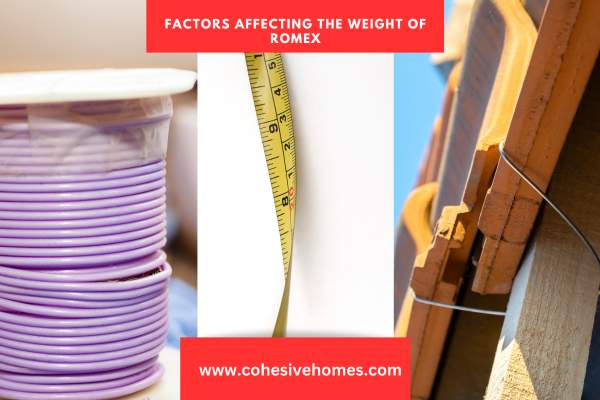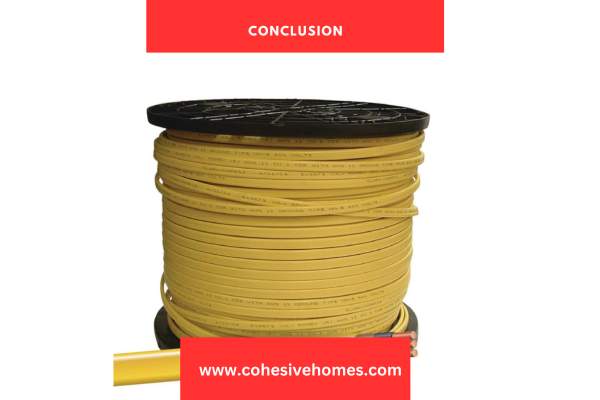Hey there, fellow DIY enthusiasts! Are you ready to delve into the world of electrical wiring and find out just how much weight we’re talking about when it comes to 1000 feet of 12/2 Romex?
Well, you’ve come to the right place! Today, we’re going to unravel this electrifying mystery and shed some light on the weighty matter at hand.
So, grab your favorite beverage, get comfy, and let’s embark on this enlightening journey together!
Unveiling the Weight of 1000 Feet of 12/2 Romex

If you’ve ever tackled an electrical wiring project, you’re likely familiar with Romex, a popular type of electrical cable used in residential and commercial settings.
Romex is known for its versatility, affordability, and ease of installation, making it a go-to choice for both professionals and DIY enthusiasts.
One common question that arises when working with Romex is, “How much does it weigh?”
Specifically, if you have a hefty 1000-foot spool of 12/2 Romex, you might be curious about the total weight you’ll be dealing with.
Let’s dive into the numbers and shed some light on this weighty matter.
12/2 Romex refers to a specific type of Romex cable with two insulated 12-gauge copper conductors and a bare copper ground wire.
The “12” indicates the wire gauge, while the “2” signifies the number of conductors.
This type of Romex is commonly used for general-purpose residential electrical wiring, such as lighting circuits and outlets.
To determine the weight of 1000 feet of 12/2 Romex, we need to consider various factors.
Firstly, the weight of the copper conductors, which is influenced by their gauge. Thicker gauge wires have more copper, resulting in a higher weight. Additionally, the sheathing or jacket material, typically made of PVC, adds to the overall weight of the cable.
How Much Does 12/2 Romex Weigh?

When it comes to determining the weight of 12/2 Romex, several factors come into play. 12/2
Romex refers to a specific type of electrical cable that consists of two insulated 12-gauge copper conductors and a bare copper ground wire.
The weight of this Romex can vary based on a few key elements.
On average, a 1000-foot spool of 12/2 Romex weighs approximately 63 to 65 pounds (28 to 29 kilograms).
However, it’s worth noting that this weight can vary slightly depending on factors such as the specific manufacturer, the thickness of the sheathing or jacket material, and any additional components included in the cable.
Understanding the weight of 12/2 Romex is crucial for various reasons.
It helps in estimating the strength needed for handling and transporting the cable during installation, ensuring safety and preventing accidents.
Additionally, knowing the weight allows for accurate planning and estimating of materials required for a particular project, avoiding wastage or shortages.
Compared to other types of electrical wiring, 12/2 Romex is relatively lightweight, making it easier to work with and maneuver, especially when dealing with longer runs or navigating through tight spaces.
Being aware of the weight of 12/2 Romex empowers electricians, contractors, and
DIY enthusiasts to make informed decisions, ensuring efficient installations while prioritizing safety.
By having this knowledge, you can confidently tackle your electrical projects, knowing exactly what you’re dealing with in terms of weight and materials
Calculating Weight Per Foot

Calculating the weight per foot of 12/2 Romex involves considering the weight of the copper conductors and the sheathing or jacket material. Here’s a breakdown of how you can estimate the weight per foot:
- Determine the weight of the copper conductors:
- Copper has a specific weight of approximately 0.322 pounds per cubic inch (or 8.89 grams per cubic centimeter).
- Calculate the cross-sectional area of the 12-gauge copper conductors using the American Wire Gauge (AWG) standard. For 12-gauge wire, the cross-sectional area is approximately 0.0810 square inches (or 5.23 square millimeters).
- Multiply the cross-sectional area by the length of the conductor in one foot to obtain the volume in cubic inches.
- Multiply the volume by the specific weight of copper to determine the weight of the copper conductors per foot.
- Consider the weight of the sheathing or jacket material:
- The sheathing or jacket material typically consists of PVC (Polyvinyl Chloride), which has a specific weight of about 0.0414 pounds per cubic inch (or 1.14 grams per cubic centimeter).
- Determine the cross-sectional area of the sheathing material by subtracting the cross-sectional area of the copper conductors from the total cross-sectional area of the Romex cable.
- Multiply the cross-sectional area of the sheathing material by the length of the cable in one foot to obtain the volume in cubic inches.
- Multiply the volume by the specific weight of PVC to determine the weight of the sheathing material per foot.
- Add the weight of the copper conductors and the sheathing material together to obtain the total weight per foot of 12/2 Romex.
Keep in mind that these calculations provide an estimate and may vary slightly depending on the specific manufacturer and variations in materials.
It’s always a good idea to consult the manufacturer’s specifications or weigh a sample section of the Romex to get a more precise measurement if needed.
By calculating the weight per foot of 12/2 Romex, you can plan your electrical projects more accurately, ensuring you have the necessary support and understanding the load you’ll be working with during installation.
Factors Affecting the Weight of Romex

| Factors Affecting Romex Weight | Description |
| Wire Gauge | Thicker gauge wires contain more copper and thus weigh more. |
| Cable Length | Longer cables will have more material and consequently weigh more. |
| Conductive Material | The type of metal used in the conductors affects the weight. Copper is the most common and relatively heavy metal. |
| Insulation Material | The material used for insulation can vary and impact the overall weight. PVC is a common choice. |
| Sheathing or Jacket Material | The outer covering material, often PVC, adds to the overall weight. Different formulations of PVC may have different weights. |
| Additional Components | Some types of Romex may have additional components, such as shielding or grounding wires, which contribute to the weight. |
Please note that the table provides a general overview of factors that can influence the weight of Romex.
The specific details may vary depending on the manufacturer and the particular type of Romex cable being considered.
Handling and Transporting 1000 Feet of Romex

Handling and transporting a 1000-foot spool of Romex, such as 12/2 Romex, requires careful planning and consideration to ensure safety and efficiency. Here are some tips and tricks to help you navigate this task:
Prepare Adequate Support
Romex spools can be heavy and cumbersome, so it’s crucial to have proper support in place. Consider using a sturdy spool stand, cable reel, or a cable dispenser specifically designed for handling long lengths of wire. These tools provide stability and make it easier to unwind the cable smoothly.
Clear Pathways
Before transporting the Romex, ensure the pathways are clear of obstacles and debris. Remove any potential tripping hazards or clutter that could impede your movement. A clear path minimizes the risk of accidents or damage to the cable during transportation.
Enlist Assistance
Don’t hesitate to ask for help when dealing with a 1000-foot spool. Two or more individuals working together can safely handle and move the Romex, reducing the strain on each person. Consider involving a colleague, friend, or family member to make the task more manageable.
Lift with Care
When lifting the Romex spool, use proper lifting techniques to avoid strain or injury. Bend your knees, keep your back straight, and use the strength of your legs and arms to lift the weight. If the spool is particularly heavy, consider using lifting aids such as straps or lifting grips to distribute the weight more evenly.
Use Protective Equipment
Wear gloves to protect your hands from any sharp edges or potential abrasions on the spool or the Romex itself. Additionally, consider using proper footwear with good traction to maintain stability while moving the cable.
Secure the Cable
To prevent tangling or unwinding during transportation, secure the loose end of the Romex to the spool using tape or cable ties. This helps maintain a neat and organized spool, making it easier to unwind the cable when needed.
Plan the Route
Before moving the Romex, plan the route you will take to reach your installation area. Consider factors such as doorways, stairs, or tight spaces that may require additional care and coordination. Minimize sharp turns or abrupt movements to avoid potential damage to the cable or surroundings.
Take Breaks
If the distance is significant or the weight is challenging to handle, take breaks at intervals to rest and avoid overexertion. Pushing yourself beyond your physical limits can compromise safety and lead to accidents.
By following these guidelines, you can ensure the safe and efficient handling and transportation of a 1000-foot spool of Romex. Remember, prioritizing safety not only protects you but also helps maintain the integrity of the cable, ensuring a successful electrical installation.
Why Romex Weight Matters

Understanding the weight of Romex is crucial for various reasons when it comes to electrical installations.
Firstly, it ensures safety during handling and transportation. Romex cables, especially in longer lengths like a 1000-foot spool, can be heavy.
Being aware of the weight helps you employ proper lifting techniques, enlist assistance when needed, and prevent accidents or injuries.
Additionally, the weight of Romex is essential for structural considerations during installation.
Knowing the weight helps determine the appropriate supports and fasteners to safely secure the cable, preventing sagging or damage.
Moreover, considering the weight is important for load capacity calculations.
Electrical systems have load limits, and factoring in the weight of Romex ensures the circuit operates within those limits, reducing the risk of overloading and potential hazards.
Estimating the weight of Romex also facilitates accurate material planning, minimizing wastage, and ensuring sufficient quantities for the project.
Lastly, Romex weight affects maneuverability and ease of installation.
Being aware of the weight helps anticipate the effort required to manipulate the cable in tight spaces or during routing.
By considering the weight of Romex, you can make informed decisions, prioritize safety, ensure efficient installations, and optimize resource usage.
Conclusion

In conclusion, understanding the weight of Romex, such as a 1000-foot spool of 12/2 Romex, is essential for a successful and safe electrical installation.
By considering the weight, you can take appropriate precautions during handling, ensure proper structural support, adhere to load capacity limits, optimize material planning, and enhance maneuverability during installation.
Prioritizing the weight of Romex enables you to make informed decisions, ensuring safety, efficiency, and cost-effectiveness throughout the entire process.
So, whether you’re a professional electrician or a DIY enthusiast, paying attention to the weight of Romex is a valuable practice that contributes to the smooth execution of electrical projects and the reliability of your electrical system.
FAQS
Does Romex weight vary based on wire gauge?
Yes, Romex weight can vary with wire gauge. Thicker gauges have more copper and weigh more.
How does Romex weight affect installation?
Romex weight impacts handling and structural requirements during installation. Proper lifting techniques and supports are needed for heavier cables.
Why is knowing Romex weight important for load calculations?
Knowing Romex weight is crucial for accurate load calculations to ensure circuits operate within capacity limits and prevent overloading.
